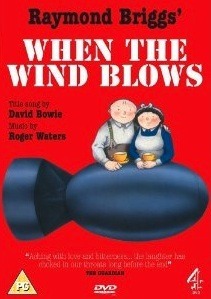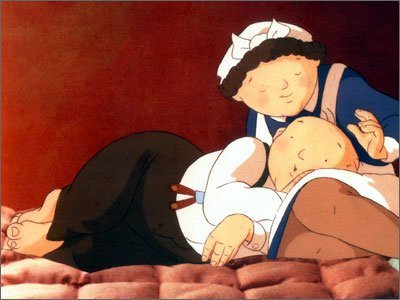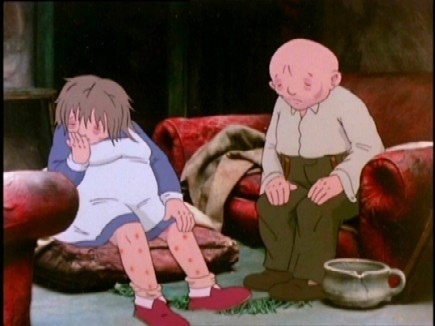When the Wind Blows
I've not been able to post here much lately, but I'll be back next week with plenty of Autumn: The City related stuff. In the meantime, here's another entry in the Post-Apocalyptic Movie Club.
 In May 1980 the British government distributed a leaflet called 'Protect and Survive' to all homes in the UK. It (along with a series of public information films like the one embedded below) was designed to provide homeowners with practical advice on how to protect themselves in the event of a nuclear attack. The original intention was to have them distributed only in time of a national emergency, but the media interest and ensuing public debate was such that they were given a general release. Fat lot of good they'd have done if the shit really had hit the fan! Shoving a few doors against a wall and covering them in mattresses and cushions might have offered some protection from the initial blast, but such a shelter, like the government publications themselves, would have done little to help the post-attack population cope with fallout, hunger, fear, desperation, cold, devastating injuries, lawlessness, etc. etc. etc.
In May 1980 the British government distributed a leaflet called 'Protect and Survive' to all homes in the UK. It (along with a series of public information films like the one embedded below) was designed to provide homeowners with practical advice on how to protect themselves in the event of a nuclear attack. The original intention was to have them distributed only in time of a national emergency, but the media interest and ensuing public debate was such that they were given a general release. Fat lot of good they'd have done if the shit really had hit the fan! Shoving a few doors against a wall and covering them in mattresses and cushions might have offered some protection from the initial blast, but such a shelter, like the government publications themselves, would have done little to help the post-attack population cope with fallout, hunger, fear, desperation, cold, devastating injuries, lawlessness, etc. etc. etc.
[There is a video that cannot be displayed in this feed. Visit the blog entry to see the video.]
Of course, back in the 1980's, generations had survived two previous world wars and regularly regaled youngsters like me with countless stories about how 'we all got on with each other in the war', and how 'it was lots of fun in the bomb shelters actually.' Did people really think surviving the nuclear holocaust would be just like the Blitz all over again? It's easy to understand why they might.
When the Wind Blows is a post-apocalyptic movie like no other. It dramatizes the effects of a nuclear attack from a unique perspective – that of a couple of naïve pensioners living in the British countryside. Based on the Raymond Briggs book first published in 1982, it's a heart-breaking, animated story.

Jim and Hilda Bloggs (characters based on Briggs' own parents) live a quiet and simple, post-retirement life. Jim's days are filled with trips to the library to read the papers, tending his garden, and taking regular naps. House-proud Hilda busies herself with endless cleaning and chores. The most important decision she has to make each day is what to cook Jim for his tea.
War is on the horizon. Jim dutifully does all he can to keep abreast of the rapidly deteriorating international situation by listening to the radio, and when it transpires that an enemy missile attack might be launched at any moment, he reaches for his copy of 'Protect and Survive'. Much to Hilda's disgust, he sets about building a fallout shelter in the middle of the house. It's his public duty, he tells her as she covers her best cushions with plastic bags and scolds him for scuffing the wallpaper.
These two survived the last two World Wars so, they decide, there's no reason why they shouldn't survive the next. They fondly remember their bomb shelters, rationing, the enemy, and many other aspects of life in wartime with genuine affection and nostalgia. Jim, a stubborn, mildly chauvinistic but well-meaning man, tells Hilda how it'll all be different now, boring her senseless with constant facts and figures: a combination of misunderstood details he's picked up from the newspapers and radio, and his own wildly inaccurate, baseless suppositions. Between them, they totally fail to grasp the implications of the coming attack and reveal themselves to be completely out of touch with reality. In one scene Jim phones his son, Ron, to ask for advice and to check that he too is following the governmental procedures to provide for his own family's safety. 'What did he say, dear?' asks Hilda. 'Nothing,' Jim replies. 'He was just laughing. He started singing… we'll all go together when we go…'

A scant couple of days later and the unthinkable happens, a missile attack is launched against the UK, and the couple barely make it into their shelter in time. They survive the initial blast, then set about making the most of life after the bomb as the world dies around them. They emerge and start to clean up their badly damaged house, all the time looking up at the clouds for any sign of fallout ('I think it's supposed to look a bit like snow,' Jim says). They collect rainwater to drink in melted milk bottles, and talk about what they need to buy when they next get down to the shops. Unsurprisingly, they both quickly become ill with radiation sickness, but Jim casually explains away their symptoms as quickly as they appear… Hilda's diarrhoea and vomiting is probably just due to nerves, he tells her, and her bleeding gums, varicose veins and sudden hair loss? Well, he decides, that's all common in middle aged people like us. It's a medical fact, he tells her, woman can't go bald! Inevitably the couple are forced to accept that they're gravely ill and that, perhaps, no-one's going to come to help them after all…

When the Wind Blows is a haunting story, lovingly told. Whilst it's clear from the outset that Jim and Hilda are doomed by a). the bomb, and b). their painful naivety, the characters are well-developed and it's easy to identify with them. Jim's constant assumptions and misquotes are both humorous and infuriating, Hilda's pride in her blast-devastated home equally so. They're voiced by two late, great stalwarts of British theatre, John Mills and Peggy Ashcroft, and the familiarity of their voices only helps give the characters a genuine, grandparent-like appeal.
Directed by Jimmy T. Murakami (the Oscar-nominated animator who directed Raymond Briggs' UK Christmas perennial 'The Snowman' and also, bizarrely, the Roger Corman-produced 'Battle Beyond the Stars'), the film was technically ambitious for the time. Produced by traditionally animating the main characters over footage of filmed, three dimensional model sets, it hasn't fared well in comparison to today's standards of film-making. That said, this is a character-, not effects-driven piece, and it remains both moving and powerful. The steady physical deterioration of Jim and Hilda and their surroundings is never gratuitous, but it's effective and works well.
It's easy to dismiss When the Wind Blows because it's a thirty-year old cartoon, but to my mind it makes some really important points and it makes them well. Back in the day, of course, it was a superb response to the inadequacies of the UK government's preparations for nuclear attack, whilst also commenting successfully on the futility of such a war. Times may have changed and the old 'East versus West' rivalry of the Cold War may no longer exist as it did, but even though the direction of the threat may have altered, it's still there and this film serves as a reminder of its grim implications.
I've got a lot of emotional attachment to this film. As I've said previously, I grew up fascinated and terrified in equal measure by the Cold War. I'm British and can identify completely with these characters (I see my parents turning into Jim and Hilda day by day), and even the soundtrack of the film (which includes David Bowie, Roger Waters and others) was the music which got me through my A Level exams. But is it just me, or has it affected other people too? I'd love to hear your thoughts…
Next time – an Oscar winning documentary made in 1965 for the BBC and banned for twenty years – I'll be re-watching 'The War Game'.
This is a post from David Moody's RSS feed. For regular updates about the HATER and AUTUMN books and films, subscribe to the feed today!
When the Wind Blows











